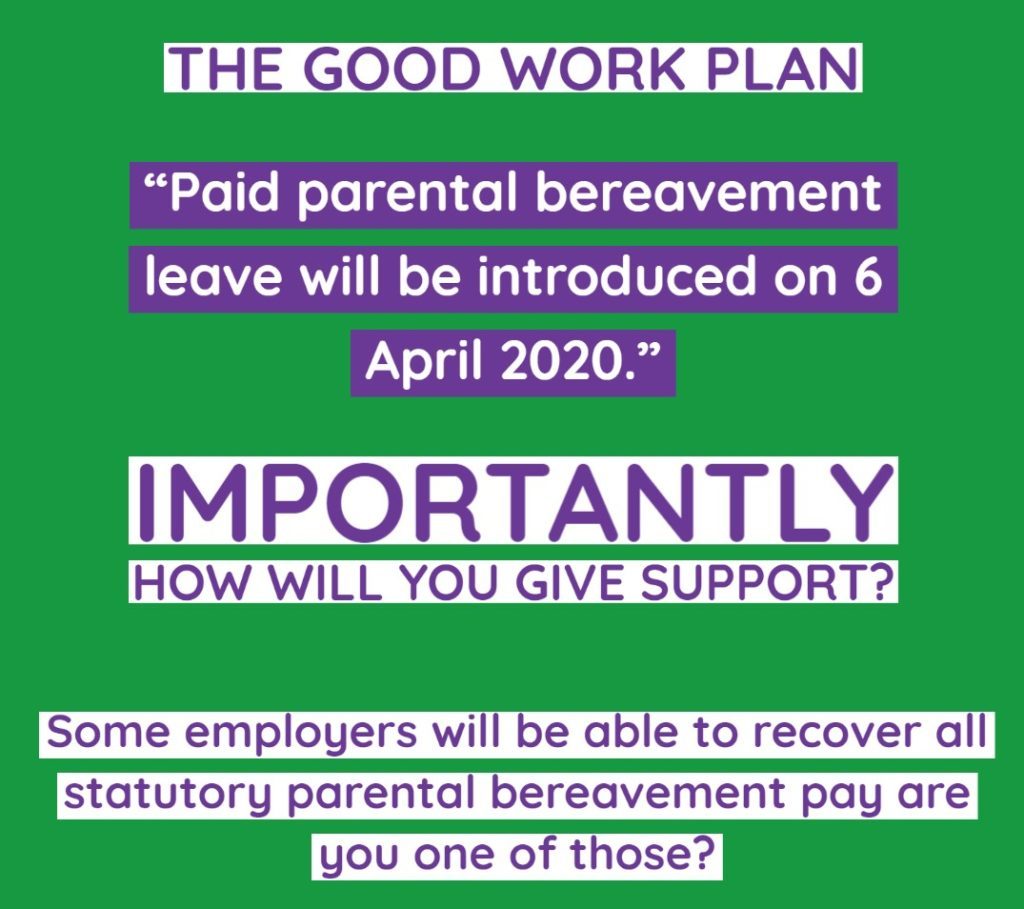Parental bereavement leave and pay will be introduced as part of the Good Work Plan from April this year.
Are you prepared?

Parental bereavement leave is a new entitlement for bereaved parents to be absent from work with pay at a statutory minimum rate for up to two weeks.
1. The timetable is tight for employers to prepare.
Employers have just over two months from the publication of the draft Regulations until they apply in their workplace since parental bereavement leave is available to parents of a child who dies on or after 6 April 2020.
However, employers should bear in mind that 6 April 2020 is a Monday. This means that many employers will want to have updated their family-related and compassionate/bereavement leave policies and procedures, and communicated them to their workforce, by Friday 3 April at the latest.
The Regulations are still to be finalised in Parliament and the Government is expected to publish guidance on the GOV.UK website. However, the timetable for the publication of the final Regulations and Government’s guidance is uncertain.
2. Eligibility extends well beyond birth parents.
The primary beneficiaries of statutory parental bereavement leave are employees who are the parents of a deceased child under the age of 18.
Parental bereavement leave is a “day one” employment right, meaning that staff do not require a minimum period of service (although there is a qualifying period for statutory parental bereavement pay.
It’s estimated that 10,200 parents per year will be eligible for parental bereavement leave, whilst 9,300 of these will be eligible for statutory parental bereavement pay too. Available data suggests that only around two-thirds of businesses provide bereavement leave already.
However, the eligibility provisions of the legislation extend to cover individuals with caring responsibility for a child who has died.
The new law adopts the concept of a “parent in fact”, defined as an individual who has, for a continuous period of at least four weeks before the child dies, been living with the child and has “day-to-day responsibility” for the child.
The new entitlement is also available, in most circumstances, to the partner of a bereaved parent, if they live together in an enduring family relationship. Parental bereavement leave entitlement extends as well to adoptive parents.
In addition, the new right allows parents who suffer a stillbirth 24 weeks or more into pregnancy to parental bereavement leave.
3. Parental bereavement leave is taken in weekly blocks.
Parental bereavement leave operates in units of one week and is not available as individual days. The weekly blocks mirror how other family leave works: for example paternity leave and shared parental leave must also be taken in weekly units.
Bereaved parents are able to take the leave as:
- a single block of two weeks; or
- two separate blocks of one week at different times.
The ability to split parental bereavement leave into two blocks means that an employee might choose to take the first week immediately after the child’s death and the second week at the time of their child’s funeral.
There may be circumstances in which the employee wishes to take only a single week’s leave, even though they are entitled to two weeks’ leave.
4. Bereaved parents have over a year to take the leave.
Under the legislation, bereaved parents can take parental bereavement leave within 56 weeks of the date of the death of the child.
This allows bereaved parents some flexibility as to when they take the leave. For example, an employee may wish to take leave around the first anniversary of their child’s death.
The 56-week time period should be particularly helpful for employees who are already on another type of leave, such as maternity leave or sickness absence.
HR professionals should ensure that a bereaved employee who is already taking maternity leave is advised that they can add their parental bereavement leave on to the end of their maternity leave.
5. A sensitive approach from line managers and HR is key.
The death of an employee’s child is one of the most sensitive situations that a line manager will ever face at work.
When dealing with this difficult situation, they should be aware that the notice and evidence requirements for taking parental bereavement leave are relatively light (although they are more onerous for statutory parental bereavement pay.
To take parental bereavement leave, an employee must tell their employer:
- the date of the child’s death;
- the date on which they are beginning their parental bereavement leave; and
- if they intend to take one or two weeks’ parental bereavement leave.
Employers need to bear in mind that there is no requirement for:
- the notice to be in writing; nor
- for the employee to provide any evidence of their child’s death (such as a copy of a death certificate or a letter from the child’s doctor).
This means that informal notification, such as a phone call or email, is sufficient to take parental bereavement leave.
Those responsible for HR should make it clear to line managers that it would be inappropriate to require a bereaved parent to provide notice in writing to take parental bereavement leave and they should obtain the necessary information in a discreet and sensitive manner.
6. Notice depends on when leave is being taken.
The length of notice that employees have to give depends on how soon after the child’s death leave is being taken. The Regulations split notice requirements into two timeframes:
- Period A: the first 56 days If an employee is beginning leave within 56 days of the child’s death, they are able to take the leave straight away, without having to give a period of notice. In practice, this means that the employee has to let their employer know of their intention to take parental bereavement leave no later than when they are due to start work on the first day of the leave. However, the legislation recognises that this is often not feasible, in which case notice can be given as soon as it is “reasonably practicable” to do so.
- Period B: after 56 days If an employee is beginning leave more than 56 days after the child’s death, a notice requirement applies. In these circumstances, the bereaved parent has to give their employer at least one week’s notice of their intention to take parental bereavement leave.
Whatever the letter of the law says, line managers and HR professionals should show an exceptional degree of sensitivity and flexibility when it comes to notice to take parental bereavement leave.
7. The statutory parental bereavement pay provisions are complex.
While parental bereavement leave is a “day one” employment right, there are additional conditions for an employee to receive statutory parental bereavement pay.
To be eligible for statutory parental bereavement pay, employees who are on parental bereavement leave are required to have:
- at least 26 weeks’ continuous employment with their employer ending with the week before the week in which their child dies, and still be employed by that employer on the day on which the child dies; and
- normal weekly earnings in the eight weeks up to the week before the child’s death that are no less than the lower earnings limit for national insurance contribution purposes.
Employees taking parental bereavement leave must give their employer notice of the weeks during which they wish to claim statutory parental bereavement pay.
The parental bereavement pay notice must normally be given before the end of a period of 28 days, starting on the first day for which they are claiming statutory parental bereavement pay. However, the legislation recognises that this is often not feasible, in which case notice can be given as soon as it is “reasonably practicable” to do so.
At the same time as the employee gives notice, they must provide evidence of entitlement to statutory parental bereavement pay. They must provide to their employer:
- their name;
- the date of the child’s death; and
- a declaration in writing that has a relationship with the deceased child that entitles them to statutory parental bereavement pay.
8. This is an opportunity to improve support for bereaved employees.
Statutory parental bereavement leave and pay is the minimum leave that employers are legally required to provide to bereaved parents.
The introduction of parental bereavement leave is an opportune time for employers to examine the support that they provide for bereaved employees.
Ways in which employers could go above and beyond the legal minimum include:
- providing employees with more than two weeks’ bereavement leave;
- paying bereaved employees their full pay for some or all of their absence; and
- allowing employees the option to take additional discontinuous days’ paid bereavement leave.
Almost all employers already offer their staff paid time off during a time of bereavement, according to the survey. For the “closest” relationship categories, which includes children, the median paid bereavement leave entitlement is five days.
However, few employers offer more than 10 days’ paid bereavement leave, meaning that many employers should now be considering if they need to increase their entitlements by 6 April 2020.
If you’re looking for advice on this sensitive subject and want to know how the proposed changes will impact your business, we can carry out a comprehensive HR audit to identify if you have the correct contracts, policies, and procedures in place before it’s too late.
Contact us by completing our secure contact form.

Alternatively call us direct on 01243-607357, or email [email protected]


